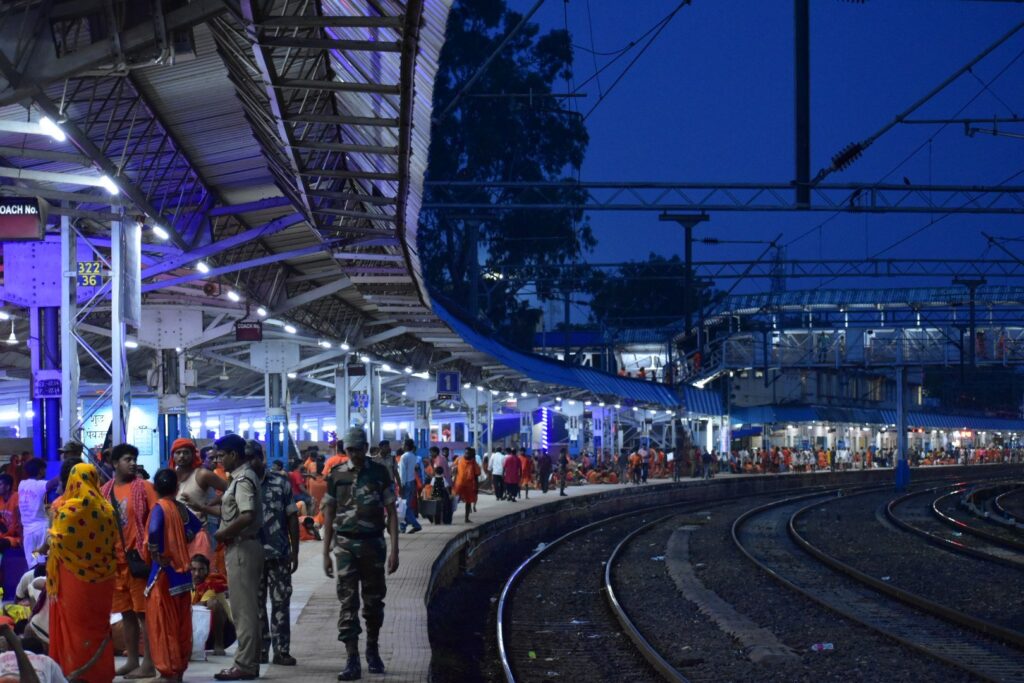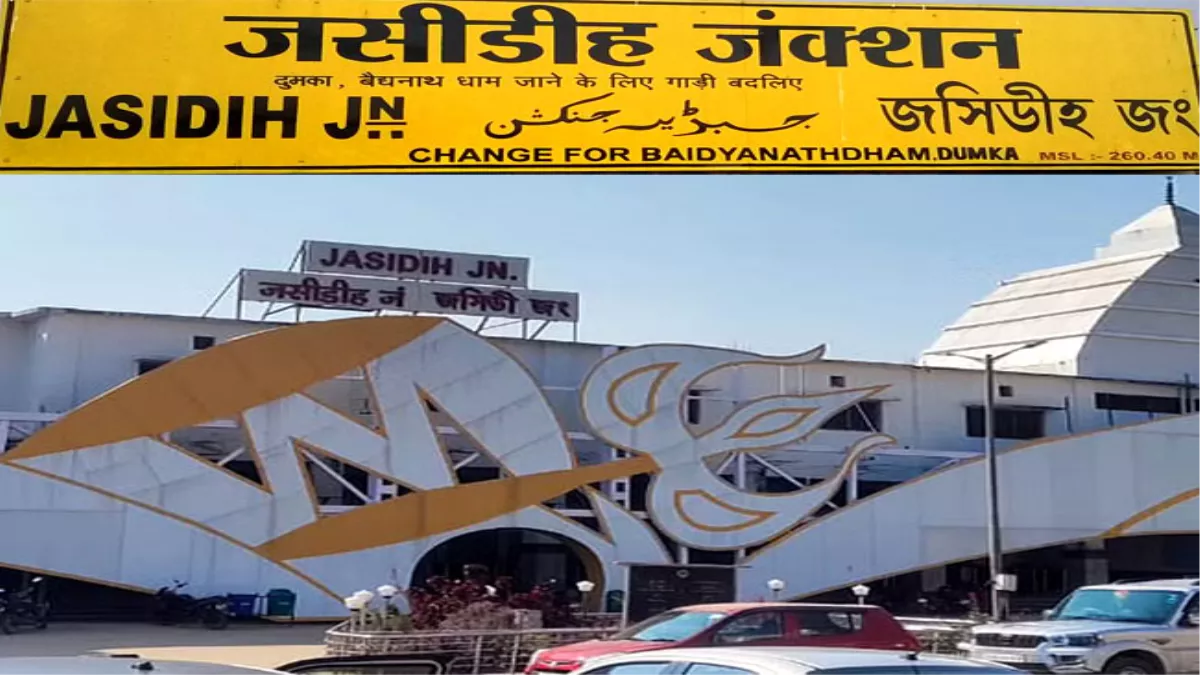Jasidih
Nestled in the Deoghar district of Jharkhand, Jasidih is a small but significant town that plays an essential role in the religious, cultural, and logistical landscape of the region. Often overshadowed by the more famous Baidyanath Dham, Jasidih has quietly established itself as the primary transit hub for millions of pilgrims visiting one of India’s holiest shrines. However, beyond its utility as a junction, Jasidih holds cultural significance, local traditions, and a quiet charm that makes it worthy of attention.
Introduction to Jasidih
Jasidih is located about 8 kilometers from the Baidyanath Temple in Deoghar, making it the most convenient stopping point for pilgrims heading toward the temple. The town itself is surrounded by modest greenery and exhibits a mix of modern infrastructure and rural simplicity. Unlike urban metropolitan areas, Jasidih provides a peaceful atmosphere, ideal for visitors seeking a pause before proceeding on their spiritual journey.
Jasidih’s growing importance stems from its excellent connectivity, thanks to its railway junction – Jasidih Junction (station code: JSME) – which links the region to major cities such as Patna, Kolkata, Ranchi, and Bhagalpur. The town functions not only as a railway hub but also as an entry point to the spiritual heart of Jharkhand.
Jasidih Railway Station: The Lifeline of Pilgrims and Travelers

Jasidih Railway Station (Station Code: JSME) is one of the most important railway junctions in Jharkhand and serves as a crucial transportation hub for travelers visiting Deoghar and surrounding regions. Its strategic location connects the region to major cities across India, making it the primary rail gateway for millions of pilgrims heading to Baidyanath Dham.
📍 Location and Connectivity
- Location: Jasidih, Deoghar district, Jharkhand
- Railway Zone: Eastern Railway Zone of Indian Railways
- Division: Asansol Division
- Elevation: Approximately 254 meters above sea level
🚉 Key Routes and Connections
Jasidih Junction connects several important railway routes:
- Jasidih ↔ Deoghar (Road connection)
- Jasidih ↔ Patna
- Jasidih ↔ Ranchi
- Jasidih ↔ Howrah (Kolkata)
- Jasidih ↔ Bhagalpur
- Jasidih ↔ Dhanbad
Multiple express and passenger trains halt here, facilitating travel for pilgrims, business travelers, and tourists alike.
Table of Contents
🚄 Important Trains Passing Through Jasidih
- Howrah – Deoghar Express
- Jasidih – Ranchi Intercity Express
- Sahibganj – Jasidih Passenger
- Jasidih – Patna Passenger
- Several long-distance trains connecting major cities such as Howrah, Ranchi, Patna, and Dhanbad.
🏗️ Station Facilities
- Multiple platforms (3–5) to handle high traffic during pilgrimage seasons
- Waiting halls and seating areas
- Clean drinking water and sanitation facilities
- Food stalls and refreshment centers
- Parking facility for taxis and private vehicles
- Restrooms and cloakroom facilities
- Digital display boards showing train schedules and platform information
📊 Passenger Traffic
Jasidih Railway Station experiences heavy passenger traffic, especially during the month of Sawan (July–August), when millions of devotees travel to Baidyanath Temple. On peak pilgrimage days, thousands of passengers pass through daily, making Jasidih one of the busiest railway junctions in Jharkhand.
🚧 Future Development Plans
Indian Railways has planned modernization and expansion at Jasidih Railway Station to handle growing passenger demand:
- Electrification of tracks: Completed, ensuring smoother and more efficient train operations.
- Improved Passenger Amenities: Plans include better waiting lounges, enhanced sanitation, and improved food courts.
- Enhanced Connectivity: Plans to add more direct trains to major pilgrimage and metropolitan cities.
🌟 Why Jasidih Railway Station Matters
For many pilgrims and travelers, Jasidih Railway Station is not just a transit point but the first step in their sacred journey toward Baidyanath Dham. Its efficient connectivity, robust infrastructure, and accessibility make it an indispensable asset in the region’s spiritual and economic framework.
The Spiritual Significance of Jasidih
Proximity to Baidyanath Dham
The most prominent reason for Jasidih’s popularity is its proximity to the famous Baidyanath Temple. This ancient temple is revered as one of the twelve Jyotirlingas, dedicated to Lord Shiva. During the auspicious month of Sawan, millions of devotees from all over India flock to the temple, many of whom disembark at Jasidih Junction to make the onward journey by road.
The temple itself is believed to be more than 5000 years old and has immense historical and mythological importance. It is said that Ravana, the mighty king of Lanka, offered his ten heads in worship of Lord Shiva here to gain invincible power.
Trikut Pahar: The Spiritual Hill
About 20 kilometers from Jasidih lies Trikut Pahar, a popular hill station offering breathtaking natural landscapes. Trikut Pahar is not only a place of scenic beauty but also a center of spiritual importance. The hill is home to several small shrines and meditation spots where devotees come for solace and to perform rituals. Visitors can enjoy panoramic views of the region from the hilltop and experience the tranquility of nature combined with spirituality.
Naulakha Mandir
Just 6 kilometers from Jasidih is the Naulakha Mandir, a temple with deep religious significance. Dedicated to Lord Krishna, this ancient structure is perched atop a hill, providing a majestic view of the surroundings. The temple gets its name from the legend that building it required “Naulakha” (nine lakhs of rupees), highlighting its grandeur and importance. The temple draws many devotees and tourists alike, seeking peace and spiritual energy.
Satsang Ashram
A short distance from Jasidih lies the Satsang Ashram, a tranquil place where followers of spiritual teachings gather to meditate, study scriptures, and attend spiritual discourses. The ashram provides a serene environment ideal for personal reflection, away from the hustle and bustle of city life. Many visitors make a stop here to gain mental and spiritual clarity before or after their pilgrimage to Baidyanath Dham.
Cultural Mosaic of Jasidih
Jasidih is more than just a transit point; it holds a rich cultural identity that reflects the heritage of Jharkhand. The local population primarily speaks Hindi, Khortha, Bengali, and Bhojpuri. The lifestyle here is deeply rooted in tradition, yet slowly adapting to modern trends.
Festivals and Celebrations
Being close to Baidyanath Dham, Jasidih shares the same fervor during major Hindu festivals, especially Mahashivratri and Sawan. During these festivals, the town becomes bustling with pilgrims, local shops offer a wide array of religious goods, and streets are decorated with lights and flowers.
Apart from religious celebrations, the local community takes part in cultural festivals like Sohrai and Karam, which are indigenous to Jharkhand. Sohrai is primarily a harvest festival, celebrated with tribal dance and vibrant wall paintings, showcasing the region’s rural artistry.
Local Markets and Handicrafts
Jasidih has small local markets that cater to the daily needs of residents and pilgrims alike. Traditional handicrafts of the region include tribal paintings, earthen pottery, and handwoven textiles. Although these markets are modest compared to urban centers, they hold immense cultural value and are a reflection of the region’s artistic heritage.
Infrastructure and Connectivity
Jasidih Railway Junction
Jasidih Junction is the lifeline of the region. This railway station sees thousands of travelers each day, especially during the pilgrimage season. It offers connections to key Indian cities, thus serving as an important logistical node for both people and goods.
The station is equipped with modern facilities including waiting lounges, food stalls, and restrooms, making the journey comfortable for travelers. It also offers easy access to local transportation such as taxis and buses, which connect Jasidih to Deoghar and nearby regions.
Road Connectivity
Jasidih is well connected by road to Jharkhand’s major cities and neighboring states. The National Highway (NH) and state highways passing through the town link it with Deoghar, Ranchi, Patna, and Bhagalpur.
State-run buses and private taxis are readily available for pilgrims and tourists. For those interested in a more scenic route, local operators provide guided tours covering nearby attractions like Trikut Pahar and Naulakha Mandir.
The Climate and Best Time to Visit
Jasidih experiences a subtropical climate with distinct seasons. Summers, from March to June, can be quite hot, with temperatures rising above 35°C. The monsoon season (June to September) brings heavy rainfall, enriching the region’s greenery but making travel slightly challenging. The best time to visit is from October to February when the weather is cool and pleasant, ideal for sightseeing and spiritual journeys.
Local Cuisine: A Taste of Jharkhand
Though small in size, Jasidih provides a window into the rich culinary traditions of Jharkhand. The local cuisine is simple, yet hearty and flavorful, typically based on rice, lentils, and seasonal vegetables. Some must-try dishes include:
- Thekua: A sweet snack made of wheat flour, jaggery, and coconut, often prepared during festivals.
- Litti Chokha: Baked wheat balls served with mashed potatoes, brinjal, or tomato chokha, garnished with mustard oil.
- Dal-Rice: A staple meal of steamed rice served with lentil curry and a side of pickle.
- Mutton Curry: Spicy and flavorful, made from locally sourced meat and traditional spices.
Small eateries near the station and town center offer local delicacies, ensuring pilgrims can enjoy a fulfilling meal during their stay.
Economic Growth and Development
Although Jasidih’s primary economy revolves around its role as a transit hub for pilgrims, recent developments show diversification in economic activities. Small-scale businesses, shops, and hospitality services are booming, especially during the pilgrimage season. The local government is gradually investing in infrastructure improvements, such as better roadways and sanitation services, to cater to the growing number of visitors.
Additionally, educational institutions and small healthcare centers have emerged, contributing to the gradual modernization of the town without disrupting its cultural roots.
Challenges Faced by Jasidih
Despite its strategic importance, Jasidih faces several challenges:
- Infrastructure Pressure: The sudden surge of pilgrims during peak seasons puts a strain on local infrastructure, leading to congestion and lack of accommodation.
- Sanitation: Inadequate sanitation services during the pilgrimage rush can lead to health hazards.
- Environmental Concerns: The influx of tourists has led to increased littering and pollution in the surrounding areas, especially near natural attractions like Trikut Pahar.
Efforts are underway to improve waste management, provide better public amenities, and raise awareness among visitors to preserve the region’s natural and spiritual heritage.
Conclusion: Why Visit Jasidih?
Jasidih may not be a standalone tourist attraction, but its significance cannot be overstated. It serves as the essential gateway to Baidyanath Dham, one of the most revered pilgrimage destinations in India. Beyond its role as a transit hub, Jasidih offers a unique blend of culture, spirituality, and natural beauty.
Whether you’re a pilgrim on a sacred journey, a traveler seeking to explore Jharkhand’s cultural landscape, or someone in search of peace amidst nature and spirituality, Jasidih promises an enriching and memorable experience.
